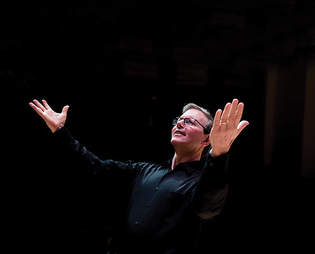
John Johansen
As shown opposite, Rob Kapilow ’75 is a conductor. He’s also a commentator, author, composer, and—we’d run out of room if we tried to list it all.
The interview, by Matthew Guerrieri, has been condensed and edited.
View full image
Conductor, composer, educator, and author Rob Kapilow ’75 gets people to listen. Over the past quarter century, Kapilow’s “What Makes It Great?” series—originally a feature on National Public Radio’s Performance Today, later expanded into books and live concerts—has made him a leading contemporary cicerone of classical music. More recently, Kapilow has also ventured beyond classical: his latest book, Listening for America: Inside the Great American Songbook from Gershwin to Sondheim, explores the inner musical workings of Broadway. He is currently working on a follow-up, examining rock and roll and its musical, commercial, and societal apotheosis during the 1960s—the Woodstock generation.
Matthew Guerrieri: The Woodstock generation—that’s your generation. But at that time, you ended up going into classical music and spent many years there. Is this like a homecoming for you?
Rob Kapilow: Ironically, I came to it in a much more roundabout way than that! [“What Makes It Great?”] grew out of my frustration, in a way. I was teaching at Yale and conducting the symphony. And whenever I was conducting the symphony, I always wanted to turn around to the audience and say, Hey, wait a minute, here’s the coolest thing in the violas that you missed. But when I was teaching, I would want the opposite—to be able to actually perform the piece to show them what we were talking about in class. “What Makes It Great?” was my chance to actually do that.
After Lincoln Center took up the series, they also started an American Songbook series. And they said to me, “We’ve enjoyed your series—could you do something with the American songbook?” Unlike a classical piece, it was music that people knew. You could show them stuff in music that they already thought they knew but hadn’t noticed. It was a great introduction for getting people to hear better. That’s what led to my last book.
I didn’t really have an idea of what to do next. I was performing a lot and traveling. And then the pandemic hit, and my literary agent said, “Time to write your next book.” And I thought, why don’t I write about what came next? Woodstock was what came next. That was the music I grew up with. What actually—so to speak—makes it great is something that intrigues me, because I’d never taken it apart. So it seemed like a perfect thing to do, because it would be as interesting for me as it would be for the reader.
MG: You’ve talked about the central line of this book’s argument being about race.
RK: That’s still the case. What’s really striking is how all these things you’re reading about the ’60s could be post–George Floyd. The exact same issues are still going on now as were going on then. W. E. B. Du Bois said, “The problem of the twentieth century is the color line.” The problem of the twenty-first century in America is still the color line.
There was a tremendous amount of white appropriation of Black music throughout the history of American popular music. American songbook com-posers appropriated African American musical styles in musical theater, white big bands in the swing era appropriated the language and techniques of African American big bands, and the origins of rock and roll involved an enormous amount of white appropriation of African American rhythm and blues. White artists began doing their own versions of R&B records—“whitifying” them and selling them to the much larger white audience. Elvis Presley “covers” Arthur Crudup’s “That’s All Right Mama” and launches his career.
At the beginning of Listening for America, there’s a quotation from Irving Berlin: that songs make history and history makes songs. And I think that was true in the ’60s as well. There are certain moments when the intersection of what’s happening in the world at large, and the music and art and culture that come out of it, is so profound.
MG: At the end of Listening for America you note that the Broadway musical has become an art form that’s basically in constant counterpoint with its own past—an art form of repertoire and revivals. I think you might make the argument that rock and roll is now this sort of repertoire art form.
RK: My daughter teaches at the School of Rock—rock history. In the early days of rock and roll, people thought it was a fad that was going to die out in two or three years. Now there’s a rock and roll museum.
History gets looked at differently based on what you know. For the Lewis and Clark anniversary, I wrote a symphony [Summer Sun, Winter Moon] for the St. Louis Symphony and two other orchestras. And I spent two years going back and forth to an Indian reservation in Montana because my collaborator who wrote the libretto, the late Darrell Kipp, was a Blackfoot poet. I wanted to tell the story of Lewis and Clark from the point of view of Native Americans. When the environmental movement comes in, suddenly Lewis and Clark are the great environmentalists.
When the feminist movement comes in, suddenly it’s all about Sacagawea. When the civil rights movement comes in, it’s all about York, the enslaved man they took along. This is what we do with history. Our George Floyd moment looks back at the ’60s in a completely different way than we would have, say, two or three years ago.
Developing a kind of historical empathy is a hard thing to do. It’s cozy, the canonical past. But it was once brand new. To get back to when it was “of the now” and being invented right before our eyes: that’s something I want to try to do.
 loading
loading